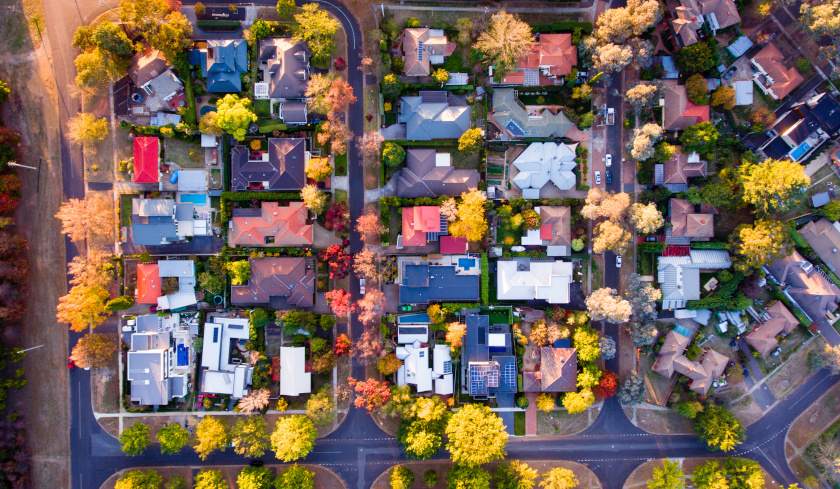Invest
House values dragged down in latest index
A new set of figures outlining the present state of Australia’s residential property market has been released, indicating a bleak outlook for growth in metropolitan areas as the Reserve Bank of Australia (RBA) is under pressure to set its first interest rate hike in more than a decade.
House values dragged down in latest index
A new set of figures outlining the present state of Australia’s residential property market has been released, indicating a bleak outlook for growth in metropolitan areas as the Reserve Bank of Australia (RBA) is under pressure to set its first interest rate hike in more than a decade.

The latest data in CoreLogic’s Home Value Index (HVI) points to a major slowdown for cities across Australia, especially Sydney and Melbourne, which have hit their first quarter of negative territory since the COVID-19 lockdowns of 2020.
The HVI figures indicating a nationwide market slowdown are backed by a deeply complex set of catalysts, which CoreLogic’s research director Tim Lawless cites as stretched housing affordability, higher fixed term mortgage rates, a rise in listing numbers across some cities and lower consumer sentiment.
Mr Lawless warned that if the RBA sets a hike in the cash rate, there will likely be a further loss of momentum in housing conditions over the remainder of the year and into 2023.
“As the cash rate rises, variable mortgage rates will also trend higher, reducing borrowing capacity and impacting borrower serviceability assessments,” Mr Lawless said.

The figures in the HVI illustrate a declining monthly rate of growth at 0.6 per cent - the lowest reading since October 2020.
According to CoreLogic, Sydney and Melbourne had the heaviest weighing in the HVI, and were the “main drag” on the headline growth rates – Sydney housing values were down by 0.2 per cent, Melbourne dropped by 0.04 per cent, and Hobart showed its first monthly fall in 22 months of 0.3 per cent.
Other cities across Australia fared slightly better, including Adelaide at 1.9 per cent growth in April, as well as Brisbane at 1.7 per cent, Canberra at 1.3 per cent, and Perth at 1.1 per cent. Although these cities indicate higher growth rates than Sydney and Melbourne, Mr Lawless warned the trend rate of growth is “easing” in most of these areas as well.
Based on rolling quarterly change, Brisbane dwellings moved through a peak rate of growth in December 2021 at 8.5 per cent, slowing to 5.7 per cent over the most recent three-month period. Similarly, Adelaide moved through a peak in the trend rate of growth in January at 7.4 per cent, reducing to 5.4 per cent in April.
But Perth and Darwin are a tale of two cities that have bucked the trend set by the others, where the rolling quarterly trend has gathered some steam since late 2021. Perth housing values were up 2.4 per cent over the three months ending April compared with a recent lull through late last year when the quarterly trend fell to just 0.4 per cent.
Mr Lawless said a rebound in migration rates as state and international borders reopened could partially explain the “renewed exuberance”, along with persistently low advertised stock levels and strong economic conditions.
“While ABS internal migration data by greater capital city is currently only reported to June 2021, the data points to a vast uplift in internal migration to Perth for the year (6,468), a substantial turn-around from the previous four-year average (-3,735).”
While Australian cities are evidently struggling with their housing values, the regional Australian housing markets have told a more upbeat story, having been “somewhat insulated” from the nationwide slowdown, according to CoreLogic.
The figures for the regions show housing values up 1.4 per cent in April across the combined regionals index, compared with a 0.3 per cent gain across the combined capitals.

Property
North platform adds household reporting feature to boost adviser efficiency
AMP's North platform has launched consolidated household reporting across multiple client accounts, helping financial advisers streamline their client review processes. Read more

Property
What Adds The Most Value To Properties?
Wondering how to up the value of your property? Properties are worth a lot of money in general, but there’s always a way to maximise value. The good news is that most of the things you can do to ...Read more

Property
Centuria reports strong growth in alternative real estate sectors for FY24
Centuria Capital Group has reported significant growth in alternative real estate sectors for the 2024 financial year, driving stable performance and increased guidance for FY25. Read more

Property
How to leverage equity in your home for investment or renovation
Home equity, the value of your property minus any debts owed, is a powerful financial resource many homeowners in Australia can utilize to further their financial goals. Whether you're looking to ...Read more

Property
Exploring REITs: Real estate investment without buying property
Real Estate Investment Trusts (REITs) offer a compelling investment alternative for those interested in the real estate market but may not want to endure the complexities and capital requirements of ...Read more

Property
Retirement communities: a pivotal element in meeting Australia's housing targets
The Retirement Living Council (RLC) has recommended that retirement communities should be considered a vital part in the Australian Government's initiative to fulfill the Housing Australia Future Fund ...Read more

Property
Australians adjust financial strategies amid changing property market dynamics
The 2023 calendar year saw Australian borrowers acquiring a total of $300.9 billion in new loans for property purchases, marking a 12.7% decrease from the previous year. Read more

Property
Split home loans unlocking doors for Aussie buyers
Australians are teaming up to dive into the real estate market and seize the advantages of home ownership, with the trend of split home loans surging as family and friends unite to buy properties ...Read more

Property
North platform adds household reporting feature to boost adviser efficiency
AMP's North platform has launched consolidated household reporting across multiple client accounts, helping financial advisers streamline their client review processes. Read more

Property
What Adds The Most Value To Properties?
Wondering how to up the value of your property? Properties are worth a lot of money in general, but there’s always a way to maximise value. The good news is that most of the things you can do to ...Read more

Property
Centuria reports strong growth in alternative real estate sectors for FY24
Centuria Capital Group has reported significant growth in alternative real estate sectors for the 2024 financial year, driving stable performance and increased guidance for FY25. Read more

Property
How to leverage equity in your home for investment or renovation
Home equity, the value of your property minus any debts owed, is a powerful financial resource many homeowners in Australia can utilize to further their financial goals. Whether you're looking to ...Read more

Property
Exploring REITs: Real estate investment without buying property
Real Estate Investment Trusts (REITs) offer a compelling investment alternative for those interested in the real estate market but may not want to endure the complexities and capital requirements of ...Read more

Property
Retirement communities: a pivotal element in meeting Australia's housing targets
The Retirement Living Council (RLC) has recommended that retirement communities should be considered a vital part in the Australian Government's initiative to fulfill the Housing Australia Future Fund ...Read more

Property
Australians adjust financial strategies amid changing property market dynamics
The 2023 calendar year saw Australian borrowers acquiring a total of $300.9 billion in new loans for property purchases, marking a 12.7% decrease from the previous year. Read more

Property
Split home loans unlocking doors for Aussie buyers
Australians are teaming up to dive into the real estate market and seize the advantages of home ownership, with the trend of split home loans surging as family and friends unite to buy properties ...Read more








